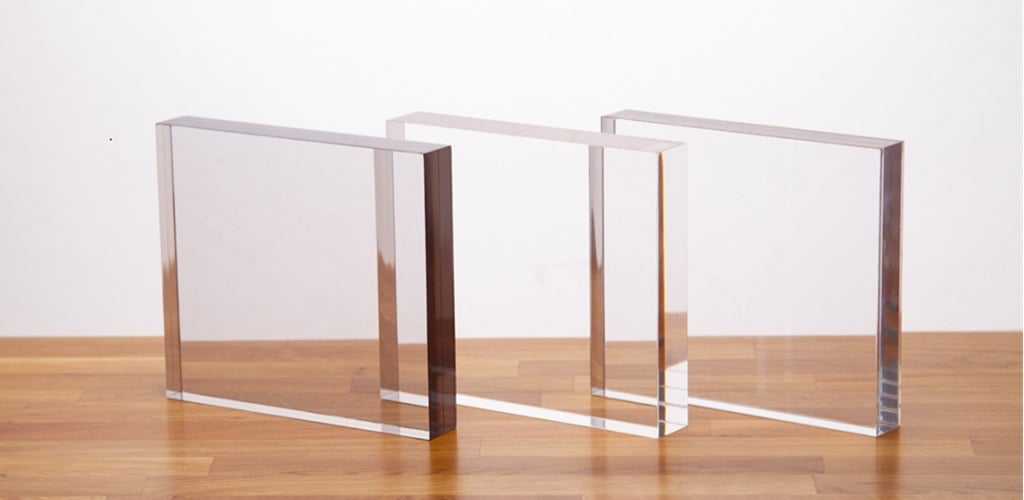Many people don’t realize how many different ballistic glass products are on the market today. You see them everywhere: pharmacies, banks, shops, schools, government buildings, community centers, houses of worship, and more. Each type of bulletproof glass has advantages and drawbacks, depending on your application, threat level, and budget. In this blog, we break down all your options.
There Are Five Primary Types of Bulletproof Glass
- Acrylic
- Polycarbonate
- Insulated ballistic glass
- Glass-clad polycarbonate
- Traditional laminated glass
Acrylic Bulletproof Glass
Monolithic acrylic is the most popular type of bulletproof glass. Composed of a single piece of 1 1/4″ to 1 3/8″ solid thermoplastic, acrylic has a remarkably high level of optical clarity. Bulletproof acrylic is tested to UL 752 Levels 1 and 2. At these levels, bulletproof acrylic can stop three shots from a 9mm handgun, or three shots from a .357 Magnum. As these are some of the most common handgun levels, ballistic acrylic is a practical, affordable solution.
Acrylic bulletproof glass is also remarkably easy to work with compared to other types of ballistic materials; it can be drilled, routed, cut, slotted, and even formed into custom curved windows. Rough-cut edges can be flame-polished clear, making acrylic the go-to material for the attractive, unobtrusive installations favored in most public buildings.
Acrylic is suitable for indoor applications. Like all plastic-based transparencies, acrylic bulletproof glass can experience crazing and hazing when exposed to UV light. Traditional, harsh window cleaners can also damage the surface of acrylic bulletproof glass.
Polycarbonate Bulletproof Glass
Polycarbonate is typically laminated between two sheets of acrylic, creating a laminated polycarbonate ballistic glass barrier. This offers a higher level of protection than either product on its own. Laminated polycarbonate products are tested to UL Levels 1, 2, and 3.
Polycarbonate is slightly less optically clear than acrylic, but using the products together helps improve the product’s visual qualities.
Insulated Ballistic Glass
Ballistic insulated glass is made up of two or more laminated glass panes separated by a sealed airspace, forming a complete insulated glass unit. Insulated glass units combine the best qualities of several different kinds of glazing. At just 1” to 1 ¼” thick, they have a slim profile. Ballistic insulated glass is tested to resist forced-entry and carries a UL Level 1 rating.
Ballistic insulated glass can be used in both interior and exterior applications; the glass caps make it easier to maintain than an acrylic or polycarbonate product. Plus, as an insulated product, ballistic insulated glass has excellent light transmission and a high r-value. These enhance occupant comfort and lower building cooling costs, but don’t carry the maintenance burden of a sensor-based or electronic window treatment.
Glass-Clad Polycarbonate Bulletproof Glass
Glass-clad polycarbonate (GCP) is made of layers of glass, polycarbonate, and an interlayer film that acts as an adhesive. It’s the most robust variety of bulletproof glass available, and is tested to UL Levels 1 through 8. Its thickness ranges from 1” to 2 ½” depending on the UL level of protection, stopping shots from handguns to AK-10s, as well as offering blast protection. Glass-clad polycarbonate can be used in interior and exterior applications.
Because of its complex construction, GCP is impossible to modify in the field. All pieces must be industrially water jet cut or hand-polished by the original manufacturer—a labor intensive process requiring special facilities.
Traditional Laminated Bulletproof Glass
Laminated glass is the original bulletproof glass. Crafted from layers of glass and resin, laminated glass is extremely heavy and difficult to work with. The experienced team at TSS does have the equipment and know-how to work with laminated glass, but these projects are rare, and typically for organizations looking for forced-entry resistance.
Choosing the Right Type of Bulletproof Glass
Your threat level, application, and budget all influence which type of bulletproof glass is right for you. If you want to protect an interior location and you’re most worried about handgun fire, an acrylic or polycarbonate glazing might be right for you. If you’re worried about rifle fire, your best option will likely be a GCP product. However, the best way to understand your options is to speak with a TSS representative who can walk you through the different types of glass.
Download the Ballistic Glazing Solutions Guide to Learn More
To learn more about ballistic glass options, download our Ballistic Glazing Solutions Guide. This free, comprehensive ebook explains the ins and outs of bulletproof glass, complementary products like framing, taking care of your bulletproof glass, and more. Download today and get started learning.

